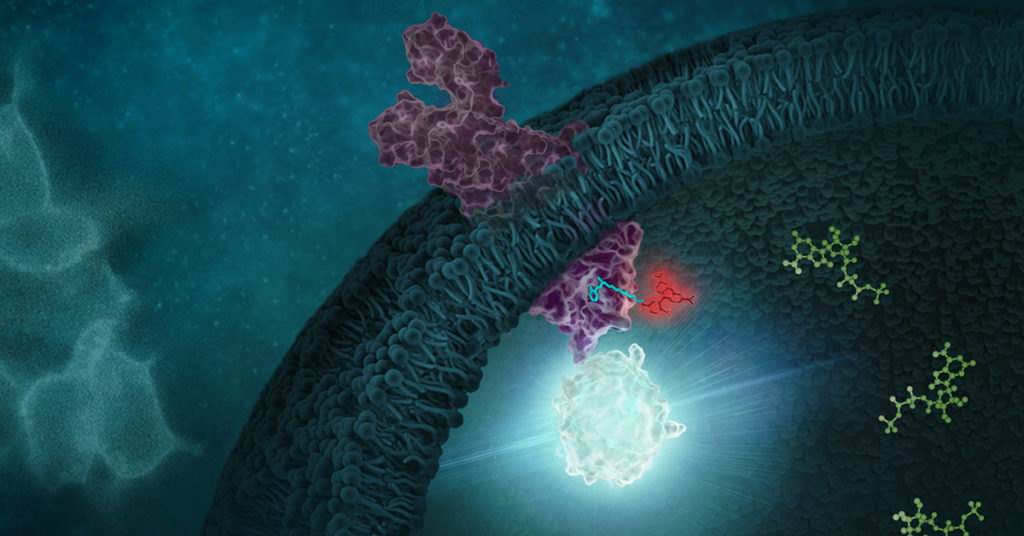Today’s post is written by Michael Curtin, Senior Product Manager, Reporters and Signaling.
Inflammation is a defense mechanism that the body employs in which the immune system recognizes and removes harmful and foreign stimuli and begins the healing process. Inflammation can be either acute or chronic. Chronic inflammation is also referred to as slow, long-term inflammation and can last for prolonged periods (several months to years); chronic inflammation is caused by immune dysregulation. This typically takes the form of the body’s inability to resolve inflammation resulting from overproduction of inflammatory cytokines and chemokines, as well as danger-associated molecular patterns (DAMPs) released from dying cells (2). Tumor Necrosis Factor (TNF) is the primary cytokine involved in many common inflammatory diseases and is where many therapies targeting inflammation are focused.

Recent research that RIP kinases (RIPK1 and RIPK3) are important regulators of innate immunity via their key roles in cell death signaling during cellular stress and following exposure to inflammatory and infectious stimuli. RIPK1 has an important scaffolding role in pro-inflammatory signaling where it interacts with TRADD, TRAF1 TRAF2, and TRAF3 and TRADD can act as an adaptor protein to recruit RIPK1 to the TNFR1 complex in a TNF-dependent process. RIPK1 plays a kinase activity-dependent role in both apoptotic and necroptotic cell death. A review article by Speir et al. (1) discusses the role of RIP kinases in chronic inflammation and the potential of RIPK1 inhibitors as a new therapeutic approach for the treatment of chronic inflammation. RIPK1 or Receptor Interacting Protein Kinase 1 is a serine/threonine kinase that was originally identified as interacting with the cytoplasmic domain of FAS. Promega offers several reagents that make studying RIPK1 easier- these include our RIPK1 Kinase Enzyme Systems which includes RIPK1 (Human, recombinant; amino acids 1-327), myelin basic protein (MBP) substrate, reaction buffer, MnCl2, and DTT and is optimized for use with our ADP-Glo Kinase Assay.
Jensen, et al. recently reviewed the use of SMAC (second mitochondria-derived activator of caspases) mimetics and RIPK inhibitors as therapeutics for chronic inflammatory diseases. In the article, they discuss that while there are therapies currently available to treat chronic inflammation, new options are needed as “many patients are unresponsive to available therapies, become intolerant to therapy over time, or experience severe adverse effects necessitating the discontinuation of therapy” (2). RIPK inhibitors may have better specificity for certain inflammatory events as compared to SMAC mimetics, which also activate other inflammatory pathways mediated by NF-κB–inducing kinase (NIK) and the noncanonical NF-κB members.
Learn more about our award winning NanoBRET™ TE Kinase Assays in this blog or check out the product on our website.
The targeting of kinases such as RIK1 for inflammation drug development has several advantages. First, it relies on approaches to drug discovery that have been tested and optimized for many years. Second efforts to identify small molecule inhibitors can take advantage of existing large libraries of small molecule compounds, and such libraries are amenable to high-throughput screening for candidate inhibitors. Any candidate molecules that do emerge can be improved through medicinal chemistry research to increase specificity, potency and other desirable characteristics using available bioinformatics and our current understanding of kinase structural domains.
To take the next step in understanding the function of these kinases in inflammation, researchers need to study kinase target engagement in live cells. One of the challenges of studying kinases is relating the data from in vitro, biochemical assays to live-cell assays. How an inhibitor behaves in a biochemical assay can be much different than it might behave in the context of a cell. When used with the NanoLuc®-RIPK1 Fusion Vector, our NanoBRET™ Target Engagement System can be used to study compound binding in live cells.
Learn about the tools Promega has to offer for studying RIPK1: RIPK1 Kinase Enzyme System & NanoLuc®-RIPK1 Fusion Vector.
Check out Promega’s portfolio of Kinase Biology content and reagents here:
NanoBRET™ TE Intracellular Kinase Assays
References
- Speir, M. et al. (2021) Targeting RIP Kinases in Chronic Inflammatory Disease Biomolecules 11(5), 646 DOI: 10.3390/biom11050646
- Jensen, S. et al. (2020) SMAC mimetics and RIPK inhibitors as therapeutics for chronic inflammatory diseases DOI: 10.1126/scisignal.aax8295
Latest posts by Promega (see all)
- Overcoming qPCR Inhibitors: Strategies for Reliable Quantification - March 13, 2025
- Celebrating Creativity and Innovation: The 2025 Promega Employee Art Showcase - February 4, 2025
- Soft Skills for the Science Lab: Develop Yourself with Promega - November 14, 2024
